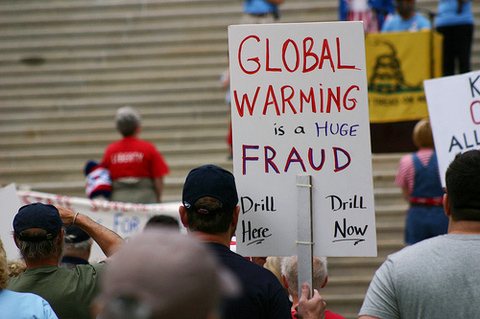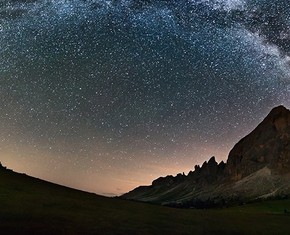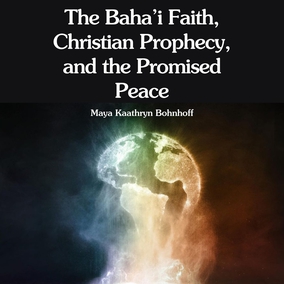The views expressed in our content reflect individual perspectives and do not represent the authoritative views of the Baha'i Faith.
If it is contrary to science and reason, it is superstition. A theory which is not acceptable to the mind of man and which science rejects is devoid of reality. – Abdu’l-Baha, Star of the West, Volume 2, p. 7.
Lately I’ve noticed that a few of my friends have begun to believe some pretty strange things.
Have you heard about “geoengineering” and “chemtrails?” This idea posits a vast conspiracy among governments and airlines to spray toxic chemicals into the upper atmosphere. Supposedly, those chemicals are meant to either a.) alter the climate, b.) manipulate humans psychologically, or c.) conduct biological warfare. This belief presupposes a secret, evil scheme that involves 40,000 commercial airline pilots taking part in a conspiratorial plot to poison us, and their own children.
But the “chemtrail” conspiracy, investigated and refuted by many established and accredited universities, scientific organizations, and major media publications, still persists despite the science.
Then there’s the 9/11 “truth movement” conspiracy theory, in which skeptics claim that the 9/11 terrorist tragedy in the United States was “an inside job,” secretly organized and carried out by shadowy, conspiratorial elements within the U.S. government itself.
 The climate change “denialist” movement questions the validity and completeness of climate science, even though the increasing rate of global warming has been repeatedly proven and accepted by the vast majority of the world’s scientists and scientific organizations.
The climate change “denialist” movement questions the validity and completeness of climate science, even though the increasing rate of global warming has been repeatedly proven and accepted by the vast majority of the world’s scientists and scientific organizations.
Of course, we’re all familiar with the “anti-vaxxer” movement, which rejects childhood vaccines and uses discredited pseudoscientific “evidence” to prove its claims.
Then there’s the ridiculous claim that western governments are monitoring all of our telephone and e-mail communications… Umm, but wait. That one turned out to be somewhat true, didn’t it?
So how do we—citizens, members of the public, mostly non-scientists—evaluate all of these theories and their disparate claims? How can we tell the difference between pseudoscience and the real thing?
The Baha’i teachings recommend two very clear courses of action for each of us—first, educate; and second, investigate:
…education is the indispensable foundation of all human excellence and alloweth man to work his way to the heights of abiding glory. – Abdu’l-Baha, Selections from the Writings of Abdu’l-Baha, p. 129.
In order to find Truth we must give up our small ideas. The fact that we imagine ourselves to be right and everyone else to be wrong, is the greatest obstacle… Therefore we must renounce our own particular prejudices and superstitions if we are in earnest in our search for Truth. Unless we make a distinct division between dogma, superstition, prejudice, on the one hand, and Truth on the other, we shall never succeed. When we wish to find a thing we search for it everywhere, therefore we must carry this principle out in our search for Truth. Science must be accepted. Light is good in whatever lamp it is burning; a rose is beautiful in whatever garden it grows; a star has the same radiance from whatever point it rises. – Abdu’l-Baha, Star of the West, Volume 2, pp. 3-4.
…we must cast aside such beliefs and investigate reality. That which is found to be real and conformable to reason must be accepted, and whatever science and reason cannot support must be rejected as imitation and not reality. – Abdu’l-Baha, The Promulgation of Universal Peace, p. 175.
Baha’is trust science, not superstition. In matters of policy, fact and faith, the Baha’i teachings say, our belief systems must all stand the clear-eyed analysis of reason and rationality:
It must agree with scientific fact and proof so that science will sanction religion and religion fortify science. Both are indissolubly welded and joined in reality. If statements and teachings of religion are found to be unreasonable and contrary to science, they are outcomes of superstition and imagination. – Abdu’l-Baha, The Promulgation of Universal Peace, p. 175.
So while hostile cabals and conspiracies could exist, our responsibility as individuals involves educating ourselves about the actual facts and using reason and science to determine the truth. Conspiracy theories and pseudoscience may console us, leading us to believe that we humans create the random, complex upheavals that trouble the world, and allowing us to see patterns where none exist—but we need to look beyond the comfort of our notions and discover the science and the factual basis of reality.
If we can do this in our daily interactions with the world, we can do it with our religious beliefs, too:
If statements and teachings of religion are found to be unreasonable and contrary to science, they are outcomes of superstition and imagination. Innumerable doctrines and beliefs of this character have arisen in the past ages. Consider the superstitions and mythology of the Romans, Greeks and Egyptians; all were contrary to religion and science. It is now evident that the beliefs of these nations were superstitions, but in those times they held to them most tenaciously. For example, one of the many Egyptian idols was to those people an authenticated miracle, whereas in reality it was a piece of stone. As science could not sanction the miraculous origin and nature of a piece of rock, the belief in it must have been superstition. It is now evident that it was superstition. Therefore, we must cast aside such beliefs and investigate reality. That which is found to be real and conformable to reason must be accepted, and whatever science and reason cannot support must be rejected as imitation and not reality. Then differences of belief will disappear. All will become as one family, one people, and the same susceptibility to the divine bounty and education will be witnessed among mankind. – Abdu’l-Baha, The Promulgation of Universal Peace, pp. 175-176.
You May Also Like
Comments

















A scientific law, an altogether different thing from a theory or hypothetical guess, is something that has been seen to hold true 100% of the time, thus far, no exceptions. The Law of Thermodynamics says that a cold substance can not contribute any energy to an already warmer object that will raise its temperature through an unassisted radiative process. In several centuries an exception has never been observed. Yet there are a surprising number of people who don't believe that Law holds true in the case of carbon dioxide. For some reason they hold that cold CO2 can perform magic, that it can function in a manner that is equivalent to placing a glass of ice water next to a hot cup of coffee causing the coffee to get hotter.
Our President recently gave a commencement address at the Coast Guard Academy focusing on the dangers of global warming and promising to 'do more...' Unfortunately, the last 18+ years of satellite data (most accurate record available) show zero warming while CO2 levels have increased 8% from 360 to 400ppm. Besides record cold and sea ice at the South Pole, the most notable increase observed has been in the net primary productivity of all trees and plants, which has grown by 2% per decade in recent decades, thanks to our 'sins of emission'. The various intertwined factors that affect the ups and down of long term climate temperature trends are, if anything, inversely correlated to atmospheric CO2 levels. Ocean warming, driven primarily by the Sun's behavior, causes an out gassing of dissolved carbon dioxide. We are now in the midst of a second consecutive 11 year solar cycle that is significantly less energetic in terms of its magnetic field strength. The last time this happened we experienced prolonged global cooling. It persisted for decades during the 'Dalton Minimum' and for centuries during the 'Maunder Minimum' which precipitated the 'Little Ice Age'. The latter was a horrific period of repeated crop failures, starvation and revolution. Global warming has always been associated with advances in health, prosperity and advances in the civilized arts. The Minoan Warm Period, the Roman Climate Optimum, and the Medieval Warm Period in addition to the current warm period are examples. ( http://climate.geologist-1011.net/ ) Cold is the killer. There are a couple of sites that are repositories of apolitical information on this contentious subject: http://www.principia-scientific.org/ & http://wattsupwiththat.com/
Richard Feynman's explanation of the Scientific Method: https://www.youtube.com/watch?v=EYPapE-3FRw
Kind Regards,
Mike Morris
I'd like to know what you think of four terms that I've used to help differentiate language which is peripheral to science.
(1) Proto-scientific language can be used to further the boundaries of science. Scientists might discuss the next stage of their research using proto-scientific terms and modes of expression. When they do so, their language will be highly constrained by science in general and by the particular context of the discipline within which the research is taking place.
(2) Quasi-scientific language is constrained by scientific findings and reasoning and, for the most part, ...terminology, but aims for more general import and to establish a broader applicability and richer standard of truth. So discussion about the applications and implications of scientific research certainly fall into this category, as do speculations about science's future.
(3) Pseudo-scientific language incorrectly claims to based in science, while embracing ideas or practices which are contrary to science.
(4) Finally, meta-scientific language discusses science 'from the outside', focusing on it as a process, as body of knowledge, etc.
Of course the boundary between (2) and (3) may not be clear to those involved. It is possible to inadvertantly embrace anti-scientific assumptions. We are particularly vulnerable to fall in to that trap when we view science from afar, taking the words of people we think are authorities without thinking critically about their context and consistency with science in general.
It seems to me that when discussing the potential for a healthy harmony between science and religion we are well served by exercising vigilance to keep our discussions firmly planted in modes (2) and (4).